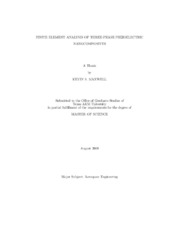Finite Element Analysis of Three-Phase Piezoelectric Nanocomposites
Abstract
In recent years, traditional piezoelectric materials have been pushed to the limit
in terms of performance because of countless novel applications. This has caused an
increased interest in piezoelectric composites, which combine two or more constituent
materials in order to create a material system that incorporates favorable attributes
from each constituent. One or more of the constituents exhibits piezoelectric behavior,
so that the composite has an effective electromechanical coupling. The composite
material may also have enhanced properties such as stiffness, durability, and flexibility.
Finite element analyses were conducted on a three-phase piezoelectric nanocomposite in order to investigate the effects of several design parameters on performance.
The nanocomposite consisted of a polyimide matrix, beta-CN APB/ODPA, enhanced
with single wall carbon nanotubes and PZT-5A particles. The polyimide and nan-
otube phases were modeled as a single homogenized phase. This results in a two-phase
nanocomposite that can be modeled entirely in the continuum domain. The material
properties for the nano-reinforced matrix and PZT-5A were obtained from previous
experimental efforts and from the literature.
The finite element model consisted of a single representative volume element
of the two-phase nanocomposite. Exact periodic boundary conditions were derived
and used to minimize the analysis region. The effective mechanical, electrical, and
piezoelectric properties were computed for a wide range of nanotube and PZT particle concentrations. A discrepancy was found between the experimental results from the
literature and the computational results for the effective electrical properties. Several
modified finite element models were developed to explore possible reasons for this
discrepancy, and a hypothesis involving dispersion of the nanotubes was formulated
as an attempt to explain the difference.
The response of the nanocomposite under harmonic loading was also investigated
using the finite element model. The effective properties were found to be highly
dependent on the dielectric loss of the beta CN/SWNT matrix. It was also found that
increasing the matrix loss enhanced piezoelectric performance up to a certain point.
Exploiting this type of behavior could be an effective tool in designing piezoelectric
composite materials.
Citation
Maxwell, Kevin S. (2009). Finite Element Analysis of Three-Phase Piezoelectric Nanocomposites. Master's thesis, Texas A&M University. Available electronically from https : / /hdl .handle .net /1969 .1 /ETD -TAMU -2009 -08 -6982.


